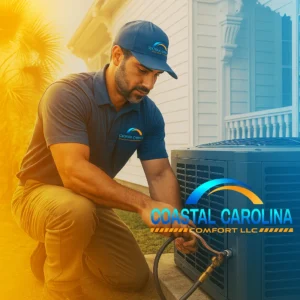Y’all, replacing that AC thermostat doesn’t have to cost an arm and a leg—or your prized fishing gear. First off, check if ya really need a new one. Sometimes, it just needs a bit of TLC. Then, do your homework and find a model that’s smart but won’t outsmart your wallet. Fancy a DIY project? Roll up them sleeves, and install it yourself. Keep your eyes peeled for them seasonal deals and don’t shy away from warranties—they’re your safety net. Follow these steps, and you’ll keep both your house cool and your wallet happy. Stick around, and we’ll show y’all how to make it as simple as pie.
Evaluate Thermostat Necessity
Before y’all go splurging on a new thermostat, let’s take a gander to see if you really need one, or if your old one’s just playin’ possum.
Now, I know it’s tempting to jump on that fancy tech wagon, especially with all these newfangled smart features whisperin’ sweet nothings ’bout energy efficiency. But hold your horses! If your current contraption ain’t broken, just consider givin’ it a little TLC. Sometimes, all it takes is a good dustin‘ or a fresh battery to get it back on its feet.
Plus, stickin’ with what you’ve got a tad longer means more time to save up for a model that’ll truly make a difference in them energy bills, without rushin’ into a decision as hasty as a cat on a hot tin roof.
Research Compatible Models
Once you’ve decided your old thermostat’s as useful as a screen door on a submarine, it’s time to saddle up and hunt for models that’ll fit your setup like a glove.
Now, y’all know not all thermostats are created equal, like biscuits and gravy versus plain toast. Aim for that sweet spot of smart compatibility and energy efficiency. It’s like choosing a fishing rod that knows where the big bass are hiding.
A smart thermostat will learn your habits quicker than a coonhound picks up a scent, adjusting your home’s temperature to your comings and goings, saving you a pretty penny on them energy bills.
Don’t get caught in a tangle of options; look for that perfect blend of tech-savvy and budget-friendly. Yeehaw to savings and comfort, y’all!
How to Fix a Broken Thermostat AC
DIY Installation Guide
Roll up your sleeves and grab a toolbox, ’cause we’re about to dive headfirst into the world of DIY AC thermostat installation, y’all.
First things first, don’t forget those safety precautions. Ain’t nothin’ more southern than safety first, am I right? Make sure that power’s off, or you might get a shock more surprising than Aunt Pearl’s secret potato salad recipe.
Now, onto the tool requirements. You’ll need a screwdriver, some wire strippers, and a level. That’s right, a level – because nobody wants a wonky thermostat. It’s like hanging a picture; only this one controls your comfort, y’all.
Follow these steps, and you’ll have that thermostat installed quicker than you can say ‘bless your heart’.
Seasonal Discounts and Deals
Huntin’ for a bargain on that AC thermostat replacement is like fishin’ in a lake full of deals during the seasonal sales, y’all. It’s all ’bout knowin’ when to cast your line. Y’see, manufacturers and energy companies are like your fishin’ buddies, always ready with a deal or two.
- Manufacturer Promotions: They’re throwin’ out discounts like beads at a Mardi Gras parade.
- Energy Rebates: Like findin’ a prize in a Cracker Jack box, but for savin’ power.
- End-of-Season Sales: When last year’s models gotta swim away to make room for the new school.
- Holiday Specials: ‘Cause nothin’ says happy holidays like savin’ a bundle.
- Black Friday Deals: The big catch! You gotta be quick, or you’ll miss out.
Warranty and Service Packages
Diving into warranty and service packages can be as sweet as a peach pie, giving you peace of mind when your AC thermostat decides to throw a tantrum.
Now, y’all know how unpredictable these gadgets can be, bless their hearts. One moment they’re cooling your home like a spring breeze, and the next, they’re hotter than a summer barbecue. That’s where extended warranties and service contracts come in handy.
Think of them as your safety net, catching you when your thermostat takes a nosedive. They’re not just any ol’ paperwork; they’re your ticket to avoiding those wallet-draining repairs.
Frequently Asked Questions
Can a Smart Thermostat Really Save More Money Than a Traditional Thermostat When Replacing an AC Unit’s Thermostat?
Y’all, a smart thermostat ain’t just fancy, it’s frugal! With its easy installation and user-friendly interface, you’ll be savin’ more dough than with the old clunker. Welcome to the money-saving club, partner!
How Do Different Climates Impact the Choice of Thermostat for Cost-Effective AC Operation?
Y’all, choosing a thermostat’s like picking your best fishing spot; it all depends on where you’re at. Humidity levels and geographic location can turn your AC operation from a hog wallow into a sweet tea breeze.
Are There Any Environmental or Sustainability Benefits to Certain Types of Thermostats?
Absolutely, y’all! Some thermostats play nice with renewable energy, making your home greener than a spring meadow. Plus, recycling programs for old units mean you’re not just tossin’ tech into the landfill. Ain’t that somethin’?
How Does the Age and Efficiency of My Current HVAC System Affect My Choice in a New Thermostat for Cost Savings?
Y’all, if your HVAC’s older than dirt and guzzles energy, picking a new thermostat can save you some green. Just don’t forget, regular maintenance and smart installation costs keep that money in your pocket, honey.
Can Integrating Other Smart Home Devices With a New Thermostat Lead to Further Reductions in AC Operating Costs?
Y’all, did ya know integrating smart home devices with a new thermostat can slash your AC bills by up to 23%? But watch out for device compatibility and installation complexity, or you’ll be sweatin’ bullets!
Conclusion
Well, y’all, we’ve danced through the daisies of cuttin’ costs on that pesky thermostat replacement. It’s like wrasslin’ a pig in mud—messy but doable.
You’ve gotta evaluate if that old hunk of junk really needs replacin’, hunt down a deal sweeter than grandma’s peach pie, and maybe get your hands dirty with a DIY adventure.
Keep an eye out for those seasonal sales, and don’t forget to sweet-talk your way into a warranty that’ll have you sittin’ prettier than a hen in a henhouse.
Remember, savin’ a penny here means more for sweet tea and porch sittin’ later. Yeehaw!


